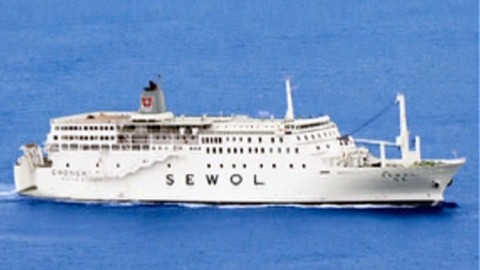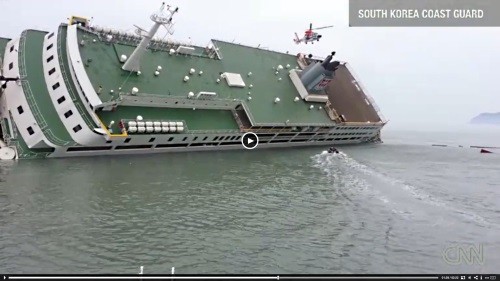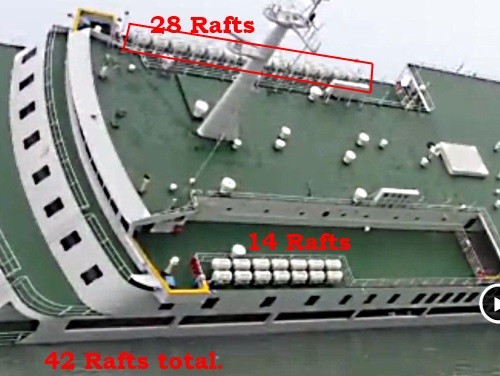South Africa’s Transnet, Union in Talks to Avoid Strike
(Bloomberg) — The biggest labor union at South Africa’s state-owned port and rail company are starting final talks with a third-party arbitrator to resolve a wage dispute and stave off...

On April 16, 2014 the Korean-flagged passenger ferry M/V SEWOL sank resulting in a large loss of life of the passengers.
While this story will continue to develop as this disaster is investigated, there are a number of questions that should be included as part of the investigation. In relation to the disaster, these are mere side-questions, in that I do not think that the answers would have changed the outcome. That said, I think these may indicate serious issues that should be investigated:
Did a lack of lifeboats on the M/V SEWOL contribute to the loss of life?
Many passengers on the infamous TITANIC died because regulations at the time did not require a place in the lifeboats for every passenger and member of the crew. Take a look at the SEWOL in the photo above. The ship had no lifeboats. Instead, it fully relied on liferafts for the safe evacuation of the passengers. This might mean that Korean authorities permitted substitution of liferafts for lifeboats. Again, looking at the photo above, there does not appear to be any boats that would have been able to marshall the rafts together.
Was it possible for the crew to evacuate the passengers using only the available liferafts?
When evacuating passengers with lifeboats, the loading of one lifeboat does not prevent the loading of other lifeboats. Liferafts sharing launching appliances (equipment required to hold and lower the liferaft) limit the loading and launching of liferafts to one at a time for each set of launching gear. The liferafts on the SEWOL appear to not have launching gear and seem to be setup to drop into the sea once released from their cradles.
There has been news reports that the liferafts might have been faulty. However, I suspect that the persons making the claims do not fully understand how these liferafts were setup to function. For example, the photos of the Captain abandoning ship show two of the liferaft canisters released from their cradles and floating in the water. The rafts had not inflated. However, this was probably by design, with the raft requiring the user to pull out the painter line from the canister which will trigger the inflation once most of it has been pulled out. As for the complaints that the canisters would not come free from their cradles, again, I suspect operator error.
The liferafts do not appear to have been equally distributed on each side of the vessel. As the vessel was listing to the port, only 14 rafts appear to have been located on that side, with another 28 trapped on the high side of the vessel.
Would placement of the liferafts have been an issue?
Take a look at the photo below (Screenshot from video in the following post: Phone Recovered from Deceased Child Reveals Shocking Error by Sewol Crew).
In the photo you can see 14 liferaft canisters on the port (left) side just behind the bridge. From the photo, it appears that there are another 28 rafts on the starboard side for a total of 42 rafts visible on the deck. Some news reports claim that the vessel had 46 liferafts. This would leave only another 4 rafts to be positioned elsewhere on the vessel. So you are looking at the majority of the vessel’s liferafts in this photo. It is not clear to me where those 4 remaining liferafts were located.


It is also not clear how passengers were supposed to board these liferafts.
If I had to guess, definitely not anywhere near where they were stored. There are no ladders. There does not appear to be any inflatable slides there either, however they could have been located elsewhere on the vessel. Looking at other photos of the vessel, there does not appear to be any obvious place for passengers to board liferafts once they were launched/dropped into the sea. If there were slides further aft, what was the procedure for marshalling the liferafts to an embarkation point?
Given that the hull below where the liferafts were located does not have any obvious embarkation areas, they must have been located further aft.
Where were the passengers expected to muster to abandon ship? Also, shouldn’t crewmembers have been stationed at the rafts? Who should have been there and where were they during this accident?
How would weather impact an evacuation from this vessel?
The seas at the time of the accident were calm, yet there were reports of swift currents in the area. Without a means to marshall the liferafts, how was the crew expected to deal with this problem? How much more difficult would it have been to carry out an evacuation of this vessel in rough seas?
Did cost play a role in the Captain’s decision-making?
The decision to abandon ship is a serious one, however there is a difference between evacuating passengers into rafts or lifeboats. There is no added cost to launching lifeboats. Lifeboats are also retrievable. There is however a cost to launching a liferaft. Once a raft is opened it will have to be serviced and re-packed.
Popping open 46 liferaft canisters would have been a considerable cost. Perhaps it was a cost the captain was trying to avoid at first, when there would have been questions regarding whether the vessel would right itself.
A couple of points to keep in mind:
This article should not be taken as a generic position against liferafts. I have to say that I started the article with that thought in mind. However, this article was written with the SEWOL incident only in mind. There are some very impressive, efficient and effective liferaft evacuation systems out there. Liferafts and lifeboats are equipment. Equipment that was not used during this accident.
Above all else, why there was no evacuation is a question that definitely needs to be answered.
Update: Some general questions when it comes to substituting liferafts for lifeboats on any vessel: Is the use of liferafts instead of lifeboats going to make the evacuation of passengers and crew easier, faster and safer? Are passengers and crew going to be better off in a liferaft? Other questions need to be asked if the answer is no.

Sign up for gCaptain’s newsletter and never miss an update

Subscribe to gCaptain Daily and stay informed with the latest global maritime and offshore news


Stay informed with the latest maritime and offshore news, delivered daily straight to your inbox
Essential news coupled with the finest maritime content sourced from across the globe.
Sign Up